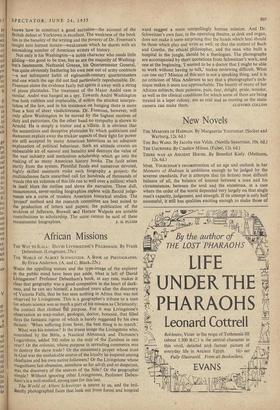African Missions
THE WAY TO ILALA : DAVID LIVINGSTONE'S PILGRIMAGE. By Frank
• Debenham. (Longmans, 25s.)
TiE WORLD OF ALBERT SCHWEITZER. A BOOK OF PHOTOGRAPHS. By Erica Anderson. (A. and C. Black, 25s.) WHEN the appalling statues and the type-image of the explorer in the public mind have been put aside, what is left of David Livingstone? Professor Debenham's book, at any rate, makes it clear that geography was a good companion in the heart of dark- ness, and he can say himself, a hundred years after the discovery of Victoria Falls, that he has seen nothing in Africa that was not observed by Livingstone. This is a geographer's tribute to a man for whom science was as much a part of his mission as Christianity; the contact that clothed Die purpose. For it was Livingstone's observation as map-maker, geologist, doctor, botanist, that filled days the fantastic rigour of which is barely suggested by his own dictum : 'When suffering from fever, the best thing is to march.'
What was his mission? Is the truest image the Livingstone who, nourished by the Bible, a Nautical Almanack and Thomson's Logarithms, added 500 miles to the map of the Zambesi in one Year? Or the colonist, whose purpose in spreading commerce was to destroy the slave trade? Or the missionary proper whose trust in God was the unshakable source of the loyalty he inspired among Chieftains and his own native followers? Or the Livingstone whose magnificent last obsession, somehow so far adrift and so desperate, Was the discovery of the sources of the Nile? Or the geographer simple? Without ignoring other Livingstones, Professor Deben- ham's is a well-studied, strong case for this last.
The World of Albert Schweitzer is nearer to us, and the bril- liantly photographed faces that look out from forest and hospital ward suggest a more compellingly human mission. And Dr. Schweitzer's own face, in the operating theatre, at desk and organ, does not make it seem surprising that the hands which heal should be those which play and write as well; or that the stutlent of Bach and Goethe, the ethical philosopher, and the man who built a hospital in the jungle, should be a theologian. The photographs are accompanied by short quotations from Schweitzer's work, and one at the beginning, 'I wanted to be a doctor that I might be able to work without having to talk,' makes reviewing difficult. What can one say? Mission of this sort is not a speaking thing, and it is no criticism of Miss Anderson to say that a photographer's tech- nique makes it seem too approachable. The beauty of many of her African subjects, their patience, pain, fear, delight, pride, wonder, as well as the clinical conditions for which some of them are being treated in a leper colony, are as real and as moving as the static

















































 Previous page
Previous page